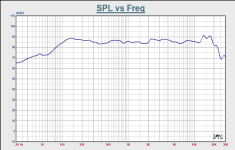Thanks Dave for sharing.
Btw, Pluvia 7 paper measurement graph does not look like that of the CHN-70... the page also says the driver has the rectangular wire for VC - IIRC first introduced with the Alpair 10.2 and was one of the tweaks/tricks to coax out bass performance from a modestly sized driver.
Btw, Pluvia 7 paper measurement graph does not look like that of the CHN-70... the page also says the driver has the rectangular wire for VC - IIRC first introduced with the Alpair 10.2 and was one of the tweaks/tricks to coax out bass performance from a modestly sized driver.
Hi. Any drivers I mention are the new models that are currently available.
That 5.3 page It shows the basket being 6mm not the 1.5mm of the new ones. I’m guessing they are committing to these new frames. I definitely don’t like them as much. I believe most would still want a rebate for it to sit in, and so you have lots more material behind the driver (a chamfer helps of course) but worse is that the screw heads stick out (well the extra plastic rings that spread the load do) and that they branded them wit the M on the front of the frame.
We were looking at 3D printing steel rings that would hide all this and possibly work as a very shallow waveguide if needed.
I think it’s the right choice for the diy market, but I’m sure other oem’s dislike these new additions?
Having said all that the test box was really nice to build entirely without a router and just use a hole saw to cut out the hole for the driver. But production ones would still have to be rebated in my opinion.
That 5.3 page It shows the basket being 6mm not the 1.5mm of the new ones. I’m guessing they are committing to these new frames. I definitely don’t like them as much. I believe most would still want a rebate for it to sit in, and so you have lots more material behind the driver (a chamfer helps of course) but worse is that the screw heads stick out (well the extra plastic rings that spread the load do) and that they branded them wit the M on the front of the frame.
We were looking at 3D printing steel rings that would hide all this and possibly work as a very shallow waveguide if needed.
I think it’s the right choice for the diy market, but I’m sure other oem’s dislike these new additions?
Having said all that the test box was really nice to build entirely without a router and just use a hole saw to cut out the hole for the driver. But production ones would still have to be rebated in my opinion.
Pluvia 7PHD on the same page...and the Alpair 7v2 MAOP looks cool.
Last edited:
@Timbre Audio
Re 5.3 was thinking a large v shallow 3d print or cnc guide cd work well to tilt and level the frequency response, seeing as it drops off slightly under 1khz or so. Then cross to a suitable driver below 450hz perhaps
It does?
That said, a 450Hz crossover could work nicely if you're using it for mid-tweet duties.
Attachments
I never much liked the pluvia/CHx (I think they were an early US halfbreed) drivers I had, has anyone got any other perspective on them, and directly compared them to the Alpairs?
The Alpairs, except for an occasional dog, are, and are intended to be, a step above Pluvia/CHx.
dave
\a 450Hz crossover could work nicely if you're using it for mid-tweet duties.
We happily use it to 250 Hz (active).
dave
@Bill, is this the same logic for the Mark Audio Sota Tozzi's waveguide shape?
TBH I havent seen this, will google it. It wd also help in terms of boosting the response slightly and time alignment.
An externally hosted image should be here but it was not working when we last tested it.
They interestingly use small waveguide in all of their cabinet designs.
The Alpairs, except for an occasional dog, are, and are intended to be, a step above Pluvia/CHx.
dave
Given that frequency and phase response can be modified at will nowadays, can you elaborate a little more?
Are you talking about decay time? If so, have you been able to get similar results from the different types of drivers once they have gone through your treatment?

They interestingly use small waveguide in all of their cabinet designs.
Ok wow thats quite a strong design! Are these meant to pair with subs?
I was thinking shallower vertical oval guide.
Given that frequency and phase response can be modified at will nowadays, can you elaborate a little more?
Are you talking about decay time? If so, have you been able to get similar results from the different types of drivers once they have gone through your treatment?
Dave is not referring to step response. He is referring to the fact that the Alpairs are the higher-end model range from MA, while the Pluvias are the standard / middle-range products, ergo a 'step' below, with the CHN/P/R units being the entry level products.
Ok wow thats quite a strong design! Are these meant to pair with subs?
If you like. They're mini-speakers for desktops, bookshelves &c. Good for about 70Hz as-is.
If you like. They're mini-speakers for desktops, bookshelves &c. Good for about 70Hz as-is.
When the plans earlier in the thread are saying poly stuffed are we talking polyester? as in pillow stuffing or do we need special acoustic pillow stuffing?
- Home
- Loudspeakers
- Full Range
- New Markaudio Drivers
